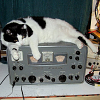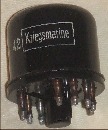Power On Delay
22 posts
• Page 1 of 2 • 1, 2
Power On Delay
When using a regulated solid state power supply for B+, is it a good idea to use a power on delay circuit?
-

kt88pppamp - KT88
- Posts: 530
- Joined: Tue Sep 26, 2006 12:11 am
- Location: Rochester, NY
Depends on:
1) The regulator design. Some have a soft-start feature that ramps up the B+.
2) The tubes. Soft start for a buch of 12AX7's would be silly. But large cathode area tubes, like EL34, sure.
Also, sometimes a relay B+ delay can add a nasty *POP!* to a system that uses low or no NFB.
Cheers!
1) The regulator design. Some have a soft-start feature that ramps up the B+.
2) The tubes. Soft start for a buch of 12AX7's would be silly. But large cathode area tubes, like EL34, sure.
Also, sometimes a relay B+ delay can add a nasty *POP!* to a system that uses low or no NFB.
Cheers!
-= Gregg =-
Fine wine comes in glass bottles, not plastic sacks. Therefore the finer electrons are also found in glass bottles.
Fine wine comes in glass bottles, not plastic sacks. Therefore the finer electrons are also found in glass bottles.
-

Geek - KT88
- Posts: 3585
- Joined: Sun Oct 21, 2007 3:01 am
- Location: Chilliwack, British Columbia
I am using a maida regulator to regulate the B+ for my PPP KT88 amp, so there is no ramp up. I plan on using a high voltage reed relays to kick on the B+ after 30 seconds. The amp will use negative feedback. I don't know how much yet. Two relays will be in the path of the AC (none on the center tap) before the rectifier and regulator circuitry. Will this configuration make a POP?
-

kt88pppamp - KT88
- Posts: 530
- Joined: Tue Sep 26, 2006 12:11 am
- Location: Rochester, NY
Hi,
Shouldn't make a pop, especially if you wire the delay just before the choke or resistor (in the case of a C-R-C), if that type of filter is used.
In my experiments, I find gNFB amps are least susceptible to the *POP*, where as local or zero NFB amps are most susceptible.
Cheers!
Shouldn't make a pop, especially if you wire the delay just before the choke or resistor (in the case of a C-R-C), if that type of filter is used.
In my experiments, I find gNFB amps are least susceptible to the *POP*, where as local or zero NFB amps are most susceptible.
Cheers!
-= Gregg =-
Fine wine comes in glass bottles, not plastic sacks. Therefore the finer electrons are also found in glass bottles.
Fine wine comes in glass bottles, not plastic sacks. Therefore the finer electrons are also found in glass bottles.
-

Geek - KT88
- Posts: 3585
- Joined: Sun Oct 21, 2007 3:01 am
- Location: Chilliwack, British Columbia
I've had luck using a 6AL5 and a transistor for a slow B+. It's basically a TIP50 with a 6AL5 from the collector to the base. The 6AL5 is set up with both diodes in series, so each side only sees half of the total B+(so it won't arch). There is a 10-22uf capacitor on the base, about a 47 to 100 on the emitter, and a 100-220 on the collector. The TIP50 will handle alot more current than the 6AL5 (and GZ34), but if you turn the power off and immediately back on, the 6AL5 will still be warm and cause a B+ surge that usually will short the TIP50, unless there is a current limiting resistor on the emitter, or the emitter's capacitor is small (47 or so). The is also a zener of 5-10 volts from the 6AL5 to the base, if you want the TIP50 to also drop 5-10 volts and basically all of the hum. Very simple circuit: AC - rectifier - cap - TIP50/6AL5 - cap - B+.
You can also use a 12X4, 6X4, EZ80, or any other weak or strong diode. The 6AL5 is prefered, because of its low filament requirement. You should also raise the filament to half of B+.
Takes about 10-12 seconds for B+ to come up, about 3-4 times as long as a 5U4.
You can also use a 12X4, 6X4, EZ80, or any other weak or strong diode. The 6AL5 is prefered, because of its low filament requirement. You should also raise the filament to half of B+.
Takes about 10-12 seconds for B+ to come up, about 3-4 times as long as a 5U4.
At first I wanted to be a ET. Now I are one.
-

DeathRex - KT88
- Posts: 1014
- Joined: Wed Nov 18, 2009 8:13 pm
- Location: Cortez, CO
Re: Power On Delay
kt88seamp wrote:When using a regulated solid state power supply for B+, is it a good idea to use a power on delay circuit?
The simplest and most fool proof thing to use is an in-rush limiting thermister. This are designed to do exactly this job at low cost. You see them used all the time in switching power supplies. In use they appear like a (say) 100 ohm resister but then after a few seconds they get warm and reduce to about 1 or 2 ohms. Put them in series with the B+ and you have a slow start B+. They come with different rating for current and different time constants. Good idea to use these as they will make recifitier diodes and filter caps last a long time and also allow you to run a smaller fuse. Normally you'd size the fuse based on worst cast current at turn on but with an in-rush limiter you might even be able to use a fast blow fuse. Maybe, I've not measured mains current yet.
The other classic design is a relay that looks like a an octal tube. These were more common 50 years ago. These have a bi-metalic strip and they switch after a fixed time delay. They were designed for delayed B+ turn on in very high power tube equipment. I think you need an RC network in any switch or relay to avoid a "thump" sound. Termisters are good because they are "soft" without the need for other parts
- ChrisAlbertson
- Posts: 120
- Joined: Tue Jun 23, 2009 10:33 pm
- Location: Redondo Beach, California
I have been looking for an appropriate B+ relay to switch that high voltage and power. I think there is no such thing as a relay that can switch 500 volts at 600mA. As a substitute, I will stick a large power FET between ground and the 10 ohm resistors. The microprocessor will make one of its pins high that is attached to the gate of the power FET. Current will then be allowed to flow through the tubes to ground. Do you see any potential problems with this configuration?


-

kt88pppamp - KT88
- Posts: 530
- Joined: Tue Sep 26, 2006 12:11 am
- Location: Rochester, NY
kt88seamp wrote:I have been looking for an appropriate B+ relay to switch that high voltage and power. I think there is no such thing as a relay that can switch 500 volts at 600mA.
Maybe a 12N05T. This is a relay inside a tube-like glass envelope with an standard tube socket base. It is normally open but the contacts close 5 seconds after you apply heater current. There are other times the "05" is the delay inseconds. These were designed for exactly this purpose, prices are between $4 and $12 depending on where you find one
THey made all different type of these here are a few
http://www.tubesandmore.com/scripts/foxweb.dll/catalog@d:/dfs/elevclients/cemirror/ELEVATOR.FXP?PAGE=SUBCAT&SEARCH_TREE01=VTUBE&SEARCH_TREE02=DELAY-RELAY
- ChrisAlbertson
- Posts: 120
- Joined: Tue Jun 23, 2009 10:33 pm
- Location: Redondo Beach, California
kt88seamp wrote:Do you see any potential problems with this configuration?
No actually, I don't.
Similar have been used for CW keying of ham transmitters for decades.
Have a R-C shaping circuit on the gate for a soft start and I think you have a winner. Though a 1 to 10K gate-snubber is always a good idea (power MOSFETS love to make V/UHF radio waves, just like a high gm tube).
Cheers!
-= Gregg =-
Fine wine comes in glass bottles, not plastic sacks. Therefore the finer electrons are also found in glass bottles.
Fine wine comes in glass bottles, not plastic sacks. Therefore the finer electrons are also found in glass bottles.
-

Geek - KT88
- Posts: 3585
- Joined: Sun Oct 21, 2007 3:01 am
- Location: Chilliwack, British Columbia
kt88seamp wrote:The microprocessor...
I'm OK with a diode, transistor/FET here and there, but I'm not down with a microprocessor. We used to sell Pioneer stereos, and one day I fired one up with no input, the digital noise was astounding. It went with the volume pot, which I guess is better than having it all the time. It had to come from the microprocessor, and the dolby digital surround processor.
At first I wanted to be a ET. Now I are one.
-

DeathRex - KT88
- Posts: 1014
- Joined: Wed Nov 18, 2009 8:13 pm
- Location: Cortez, CO
ChrisAlbertson wrote:Maybe a 12N05T. This is a relay inside a tube-like glass envelope with an standard tube socket base. It is normally open but the contacts close 5 seconds after you apply heater current. There are other times the "05" is the delay inseconds. These were designed for exactly this purpose, prices are between $4 and $12 depending on where you find one
The Amperite relays need to control another relay for a few reasons,
first, they can't handle the current, second, you want to open the
path to the coil and let it cool off after the time delay. If it stays "hot"
and a quick power outage comes along, it won't have any delay time
and will slam your circuit back on, third, the life will be shortened
by leaving it hot all of the time.
Here is my drawing of the circuit Amperite suggested in one of their
old catalogs ... I use this in my 300B amp with Mercury Vapor Rectifier.
I used a 6 volt version, and a 6 volt AC slave relay ... works great.
So far, I've resisted the temptation to mix tubes and solid state devices
as much as possible, so this was a throwback circuit to like 1939.

-

TomMcNally - Darling du Jour
- Posts: 2729
- Joined: Sat Nov 19, 2005 2:19 pm
- Location: Northfield, NJ
All the microcontroller has is delay loops that make the driver FET high after 30 seconds and the B+ FET high after another 10. It also controls the standby by cutting off or on the current when a pushbutton switch is stuck. There is no high frequency switching or any kind of fancy algorithms that is likely present in the Dolby processor. The MCU circuit will be powered off the filament winding with a 7805 regulator so nothing will actally be in the audio signal. Can noise with this setup still pose a problem?
-

kt88pppamp - KT88
- Posts: 530
- Joined: Tue Sep 26, 2006 12:11 am
- Location: Rochester, NY
Dude.... a microcontroller to do the job of a 555? 
Oh heck, yes.
One of the more popular mods I do to Jadis or L'Audio is rip all the digital stuff out - instant 40dB improvement on noise
Cheers!

kt88seamp wrote:Can noise with this setup still pose a problem?
Oh heck, yes.
One of the more popular mods I do to Jadis or L'Audio is rip all the digital stuff out - instant 40dB improvement on noise

Cheers!
-= Gregg =-
Fine wine comes in glass bottles, not plastic sacks. Therefore the finer electrons are also found in glass bottles.
Fine wine comes in glass bottles, not plastic sacks. Therefore the finer electrons are also found in glass bottles.
-

Geek - KT88
- Posts: 3585
- Joined: Sun Oct 21, 2007 3:01 am
- Location: Chilliwack, British Columbia
OK, if I were to go the glass tube timer relay route, which slave relay would I use that can withstand the 500 volts at 600 mA?
-

kt88pppamp - KT88
- Posts: 530
- Joined: Tue Sep 26, 2006 12:11 am
- Location: Rochester, NY
22 posts
• Page 1 of 2 • 1, 2
Who is online
Users browsing this forum: No registered users and 60 guests
